Where: Budapest, Hungary
When: 23-26 June 2012
'Egészségedre' meaning 'Cheers!' is one of the few words I was able to learn while I was in Budapest (Hungary). As we were told, Hungarian is one of the top 5 most difficult languages ever (along with Arabic, Chinese, Japanese and Korean... yes, imagine that) and learning it is considered a great achievement. For doing just that Elisabeth of Austria (also known as Queen Sisi) got a monument, a bridge and a statue named after her. So 'egészségedre' is the beginning of my future street in Budapest. ;)
But before I get there, let me tell you about my trip. We got to Budapest airport late in the evening. We took the 200E bus (which operates between 4 am and 11 pm; during the night, there's another bus - 900, which makes connections with other buses in order to reach the centre; make sure you check the airport website if you're ariving at night). So we validated our tickets inside (I've learned this the hard way but I always check if I have to validate my ticket in any means of transportation abroad... in Budapest, you have to do that), which we bought from a kiosk at the airport for 320 HUF. In Hungary, they pay in forints and 320 HUF is like 1.12 euro. It's kind of hard to get used to that. You know, paying thousands of cash for dinner. But you don't really have a choice. You can pay in euro in most places but it's not advisable, since they'll be using their own exchange rates.
So anyway, back to the trip. Once we got to the subway, it was really easy. There're 3 lines there, one of which is the first electric subway ever created (1896):
 |
| First Electric Subway |
We called it 'The Jolly Metro' because of the tone they played on every station. It was like we were in a cartoon (which was exactly the opposite of the other two lines with the saddest tone ever).
We quickly found our apartment, left our bags and got out. We found ourselves in this park, where there were hundreds of young people sitting, talking, drinking beer. And then we remembered. It was Saturday. To top that, there was a football match (Euro 2012 kind of thing) and all over Budapest there were screens outside cafes and restaurants and many, many people watching the games.
First impression: very good. The city was alive.
We grabbed a quick bite and found this spiral chips that went very well with the beer (coke in my case... not the biggest beer fan):
 |
| Chips |
Soon we were on our feet again, walking around the city at night (real beauty, I'm telling you). And there was the first big sight right in front of us:
 |
| St. Stephen's Basilica (Szent István-bazilika) |
St. Stephen's Basilica, the largest church in Budapest, is named after Stephen, the first king of Hungary. He is probably the most important patron of the city. Long after his death, when they were moving his remains, they found out that his right arm was incorrupt. A miracle, as they say. They kept it as a relic.
On the next day, we decided to go on this Free Walking Tour we read about - people gather and some local guides take them around the city. In return, people show their appreciation by giving tips. It's optional of course, but it would be nice, since they've taken their time to show you around and explain the history of Hungary and some interesting facts about it.
So, we headed to the meeting point - a fountain with lions on Vörösmarty. We walked to there and when we reached Vörösmarty utca (street), we searched for the fountain, only to realize, the meeting point was actually at Vörösmarty tér (square). It's not a trip if we don't get lost at least once. We took the 'Jolly Metro' and reached the square in 5 minutes. Thankfully, they hadn't left without us:
 |
| The lion fountain at Vörösmarty tér |
There were people from all continents there and since we were too many, they divided us in three groups with three different guides. We ended up with the cutest. ;)
We started walking to Danube river (Duna in Hungarian). Our first stop was at the... I don't remember the exact name of it, but it was a building, hosting a large number of classical music concerts:
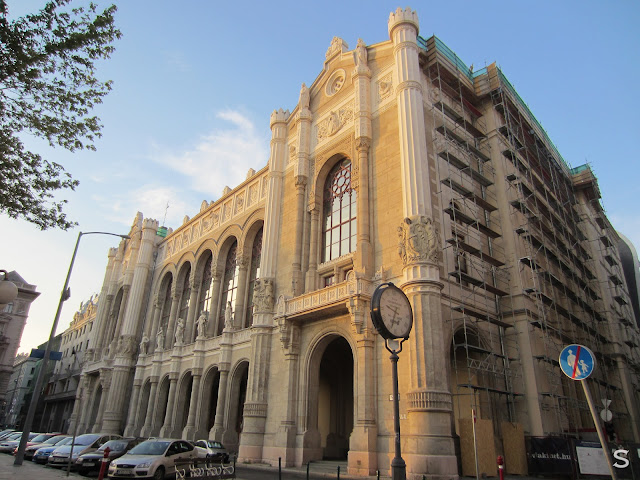 |
| Classical Music Hall? |
There we talked about the history of Hungary, which appeared to be very sad. Lots of lost wars and territories. A lot like ours.
It all started with the seven tribes that inhabited the area in 896 - the Magyar. Hungarians are still called Magyars though as years passed, they've mixed with other nations (Romanians, Slavs, Ottomans, Germans, Slovaks, Serbs, Croats and others). Nowadays it's hard to find a pure Magyar.
After they crowned their first king, Stephen, they accepted Christianity and soon developed a strong army, which led to Hungary becoming a powerful kingdom. But then in the 13th century, it lost nearly half its population to a Mongol invasion.
King Matthias Corvinus was the last strong king known (15th century) but he left no heir. Soon the Ottomans took over and stayed for around 150 years. In the end of the 17th century, the Habsburgs (Austrians) finally defeated the Turks but forgot to leave. So until the revolution in 1848 Hungary was part of the Habsburg Monarchy.
Not long after (1867) the dual Monarchy of Austria-Hungary was formed. The era was good, witnessing economic development and modernisation. Until World War I when Austria-Hungary sided with Germany (and Bulgaria) and lost. By the end of it Hungary was no longer a part of Austria-Hungary. Many of its territories were taken so nowadays Hungary is 'surrounded by itself.'
World War II was no better. Hungary again sided with the wrong party and again suffered great losses. After the end of it Soviet troops occupied the country and communism settled until 1989, when USSR stopped being invloved and Hungary was declared a republic.
After our guide explained all those tragedies, we continued to Danube. There, on the other side was Gellert Hill, on top of which was situated the Statue of Liberty:
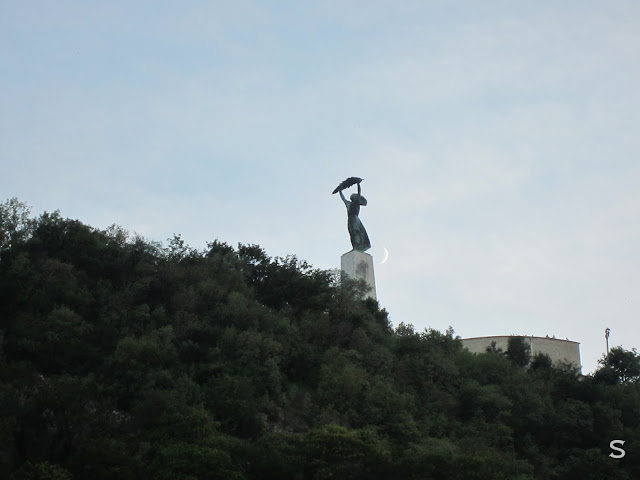 |
| Statue of Liberty |
It symbolizes the Soviet liberation of Hungary from the Nazi forces during WWII. When there was no longer Soviet influence over Hungary, the government wanted to take the statue down but instead they covered it with white sheets, stained with blood for a couple of days and when they removed them, the statue was cleansed.
We continued down the river, where there's a statue of a little girl. There's a superstition that if you touch her knee and make a wish it will come true.
We soon found ourselves by the statue of Joseph, who had a big part in rebuilding Pest, after the big flood in 1838, which made 70% of its buildings collapse.
 |
| Joseph |
So basically most of the buildings are not more than 150 years old. The city has been built and rebuilt too many times, every time restoring its original look as closely as possible.
Our next stop was in a park, where we found the safest tree in whole Budapest:
 |
| Safest Tree in Budapest |
The padlocks are like those in Verona. You engrave yours and your beloved one's names on it and lock it there. Then you throw the key in Danube. For those who doubt themselves and are not sure if they'll make it to Danube before re-thinking the situation, there are special kinds of padlocks:
Also important to know is that the Hungarian population is decreasing. So, as the guide said: "Come to Budapest and make love!"
I don't know if it was by accident or on purpose but after the love tree, we ended up at St. Stephen's Basilica again.
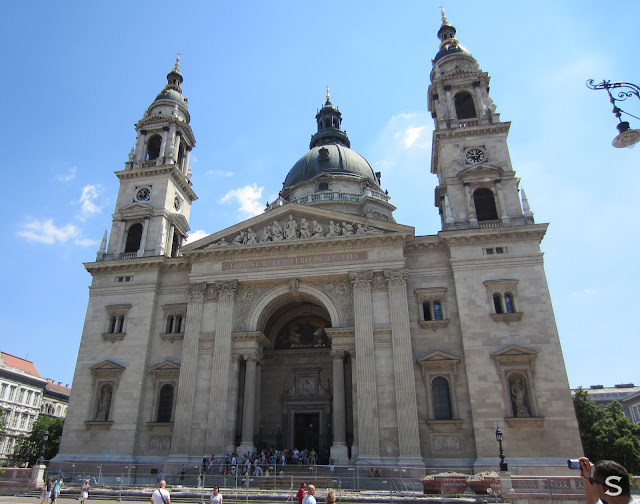 |
| St. Stephen's Basilica (Szent István-bazilika) |
This is how it looks during the day.
Our next stop was next to this nice policeman:
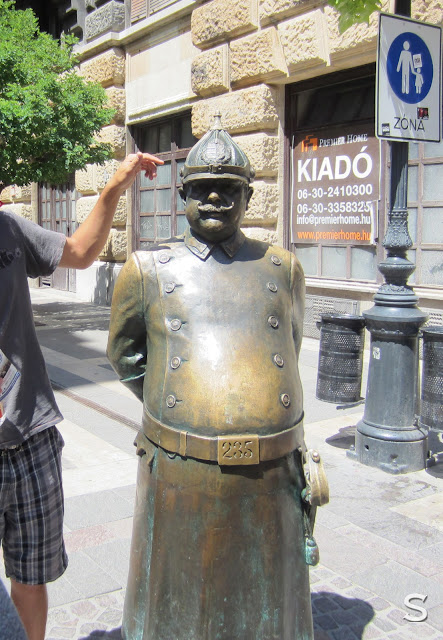 |
| Policeman |
... whose belly is to tell us how delicious the Hungarian food is. The country is known for its kitchen. Some local meals are goulash, which is basically a beef soup, paprikash - some kind of a pepper stew and a special strudel made with cottage cheese instead of apples. They also cook with plenty of garlic and deep fry a lot.
The Hungarian Academy of Science:
 |
| Hungarian Academy of Science |
It's not an academy, in which people go to study, but to work. A lot of brilliant inventors used to work here such as Rubik, the inventor of the Rubik's cube, Biro, who invented the ballpoint pen, Asboth - inventor of the helicopter, Albert Szent-Györgyi, who discovered vitamin C and many more. Another famous Hungarian is Franc Liszt (or Liszt Franc, as you'll see it in Budapest, since Hungarians write their family name first). Liszt is a composer, whose work can be heard in the Tom & Jerry cartoons.
The Academy is situated close to the Chain Bridge, which is one of the greatest sights of Budapest. It connects the two parts of the city - Buda and Pest.
Pest is the side I've been telling you about so far (with the exception of the Statue of Liberty, which is on the Buda side). Pest, which comprises 2/3 of Budapest's territory is mostly flat. Buda on the other hand is wooded and hilly. That would explain why the big flood didn't damage the Buda side. It is also the wealthier part of the city. The name has no connection to the Buddhism. Both parts used to be separate cities when they united (together with Obuda) in 1873 and became Budapest.
The Chain Bridge has its name because of its structure. It's made of chains.
 |
| The Chain Bridge (Lánchíd) |
We crossed the bridge to the Buda side and climbed up Castle Hill. On our way we saw Buda Castle:
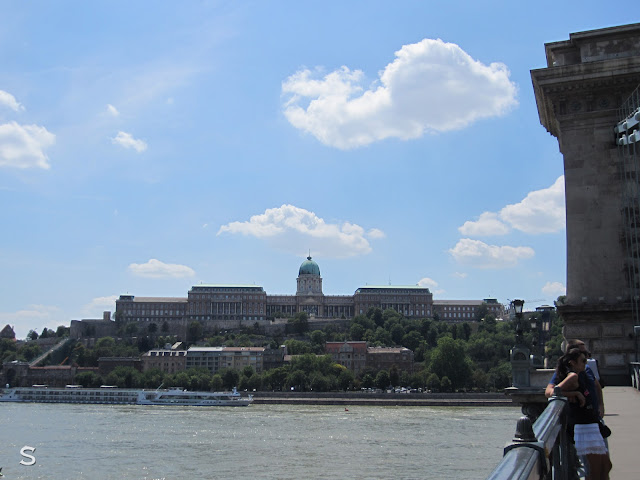 |
| Buda Castle |
It actually has never been occupied by the Hungarian Royal family. As many other buildings here, it was destroyed and rebuilt. Nowadays it houses the National Gallery, three museums and the National Library.
On top of the hill there was the president's office, which was guarded by guardsmen on each side.
 |
| Guardsman |
They were all wearing sun glasses since it was really hot and sunny and also performed a show when they exchanged positions (we have the same thing here).
Also on top of that hill was the sculpture of a Turul bird, which looks like an eagle (but it's actually a mythological falcon-like bird):
 |
| Sculpture of a Turul Bird |
This bird is a part of the story of how the Magyars settled in the Hungarian homeland.
The view to Pest was pretty good from up here:
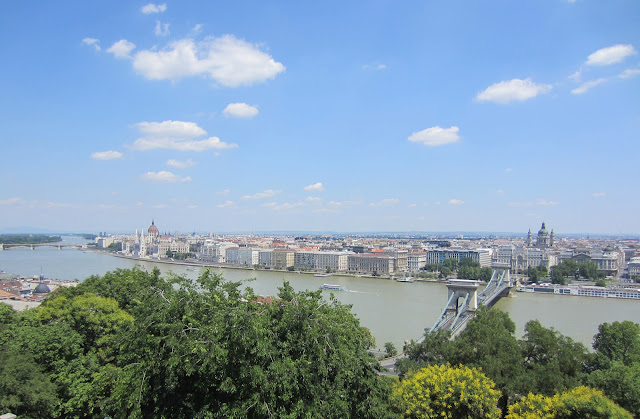 |
| Pest (view from Castle Hill) |
The guide asked us which one we thought was higher - St. Stephen's Basilica (the tallest building on the right) or the Parliament (the one on the left). It turned out they are equally high - 96 meters, which symbolizes that worldly and spiritual thinking have the same importance.
Next on our way was Matthias Church.
 |
| Mathias Church (Mátyás templom) |
The Hungarian king Mátyás held both of his weddings there. It's in eclectic style, as many of the buildings in Budapest. The roof is restored and is different from what it used to be originally.
Next to Mathias Church is the Fisherman's Bastion:
 |
| Fisherman's Bastion (Halászbástya) |
It is named after a medieval fishmarket once nearby and the Guild of Fishermen who defended this section of the wall during past wars. It has seven towers, because of the seven Magyar tribes, who populated the area. The statue on the right is of St. Stephen.
Right there our Free Walking Tour ended and after the super pleasant experience we continued on our own, straight to the Synagogue:
 |
| Dohány Street Synagogue (Dohány utcai zsinagóga/nagy zsinagóga) |
It is the largest synagogue in Europe and fifth largest in the world. It's actually difficult to capture it with one shot. This is just part of it.
It was getting dark so we decided to take a boat on Danube. On our way we passed Vaci street - another famous place in the Hungarian capital.
 |
| Váci street (Váci utca) |
It is one of the main pedestrian streets in the centre of Budapest and features plenty of shops and restaurants (overpriced, according to locals).
We reached the other end, without doing any shopping and we soon found ourselves on the boat, witnessing a marvellous sunset:
 |
| Sunset in Budapest |
We went under the Chain Bridge
 |
| Chain Bridge |
... and reached the Parliament:
 |
| Parliament (Országház) |
The Parliament is the largest building in Hungary and if I remember correctly, the 4th biggest administrative building in the world. It was even further in the competition before Ceauşescu built his parliament in Bucharest. An interesting fact is that the Parliament was constructed to look like the Buckhingham Palace in London, except for the dome in the middle.
We made a turn there, and continued backwards, passing by the sights on the Buda side, we saw earlier. On the other end, we reached Rákóczi Bridge, where we turned back but before that we sailed under Liberty Bridge:
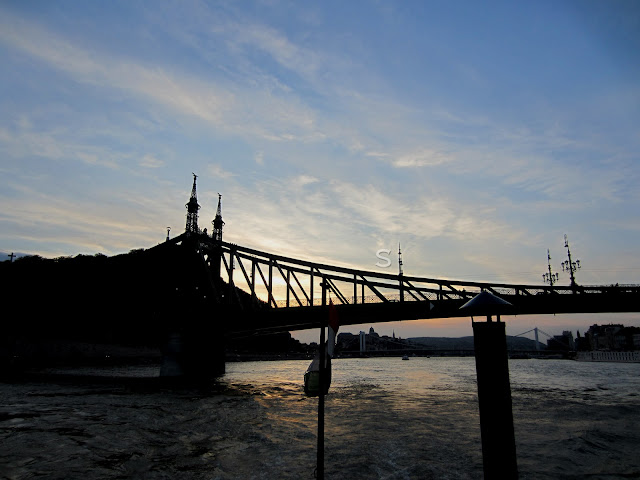 |
| Liberty Bridge |
When we got off the boat, we decided to take a walk around the city at night. On our way we stopped by to listen to a guy playing music on glasses:
You wouldn't believe the marvels we saw next:
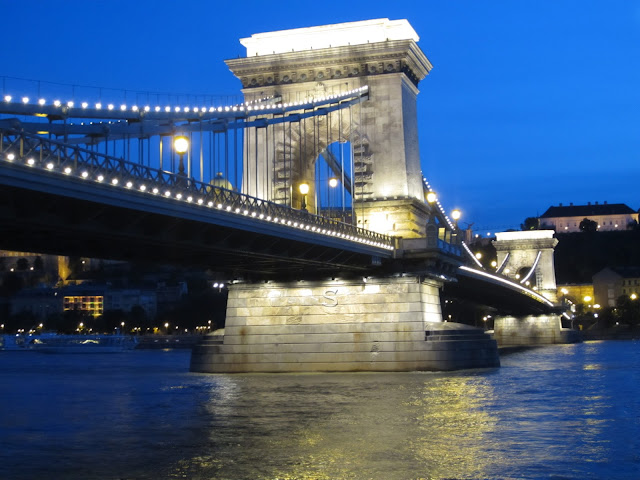 |
| Chain Bridge |
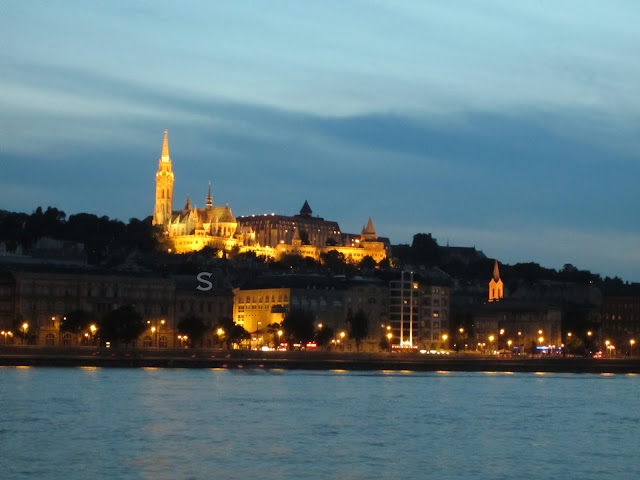 |
| Mathias Church & the Fisherman's Bastion |
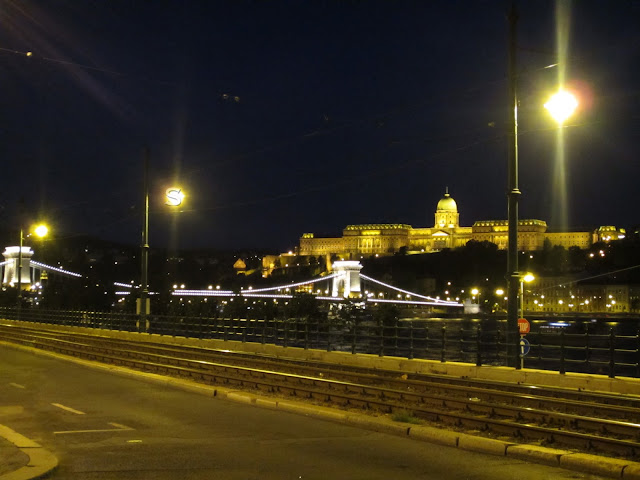 |
| Chain Bridge and the Buda Castle |
 |
| Parliament |
And that was as much beauty as we could take for one day. After we made a circle around the Parliament, we decided it was time for another form of entertainment so we ended up in a wine bar across St. Stephen's Basilica, watching the end of Euro 2012's Italy-England match.
 |
| Wine Bar |
Okay, we didn't actually sit at the wine bar, but at a fontain right next to it.. which was even cooler. ;) After we finished those glasses, we went back to the apartment, still excited about the amazing day, we've had only to find the weirdest thing in the fridge:
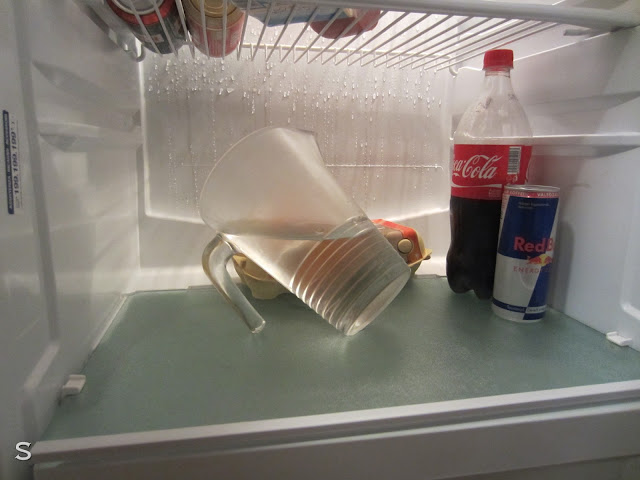 |
| Gravity? |
None of us had anything to do with it (or at least none admitted). The jug was just laying there like that on its own.
Day 3 was rainy. We had the perfect plan for it: visit the City Market Hall, get some food and spend the day at the City Park and the zoo. Well, it didn't quite work that way.
We did go to the City Market Hall:
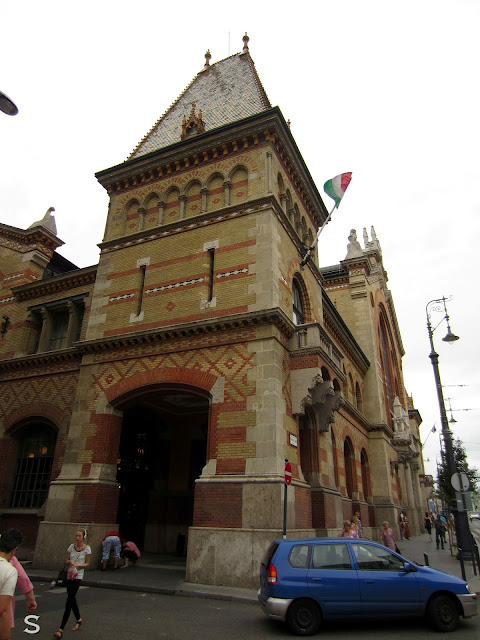 |
| City Market Hall |
But instead of food we only got some souvenirs. It was pretty crazy inside. Lots of goods and tourists.
On our way back we went past the Hungarian National Museum:
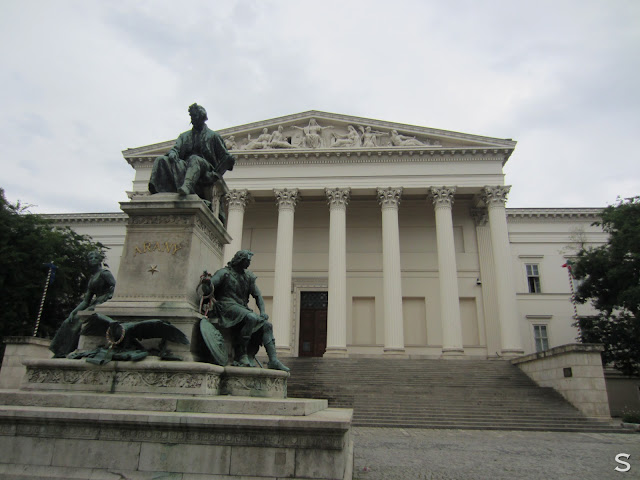 |
| Hungarian National Museum |
We didin't get inside, because on Mondays, museums in Budapest are closed. But we stuck around to take some photos, one of which was this composition: us beside the pillars in the back. One pillar - one person. So we set the self timer to 10 seconds but they weren't enough for one to climb the stairs. And every photo ended with someone running up with their back to the camera.
The next few hours, we spent at this restaurant we read about on the plain. As lucky as we were, it turned out to be situated in the building where our apartment was. It was a buffet, so we got to try many different foods, including that strudel I mentioned somewhere above:
 |
| Strudel |
In the evening the rain had stopped. So there was still hope for our plan. We took the subway to the City Park. But (of course) we missed our station. We had this small map of the city and judging by it, the park was supposed to be at the last metro station. Well, it turned out that the last station, shown on our map, wasn't the last station of the subway. So we went back on foot and soon reached the park:
 |
| City Park |
On its main entrance was Heroes Square:
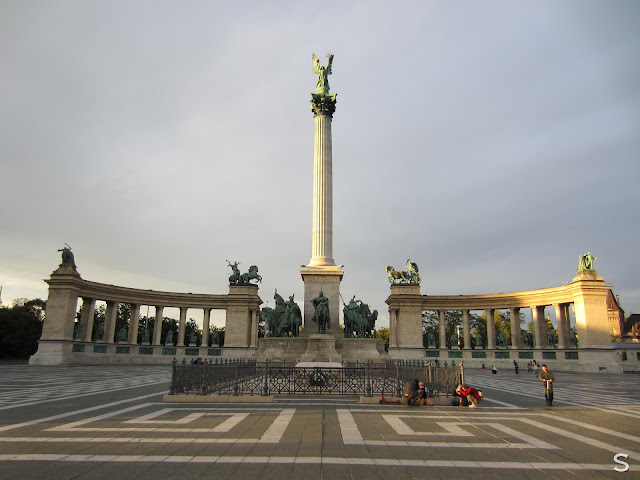 |
| Heroes Square (Hősök tere) |
On top of the column sits Archangel Gabriel. According to the story, he appeared in St. Stephen's dream and offered him the crown of Hungary. In the back, on the colonnades stand statues of Hungarian kings and heroes.
On the sides of the square lay the Palace of Art and the Museum of Fine Arts :
 |
| Palace of Art |
 |
| Museum of Fine Arts |
We followed Andrássy Avenue on our way back, not crossing any red lights, since the fine is like 100 euro, went past the Bulgarian embassy and saw this spooky building:
 |
| Andrássy Palace Gardens |
The only thing missing were the bats flying around the tower...
After taking some more gorgeus pictures of the sunset...
 |
| Sunset Mirror |
... we ended the day in a local restaurant, trying their pálinka (a strong alcoholic drink made of fruits), followed by a bar, quite famous around the city:
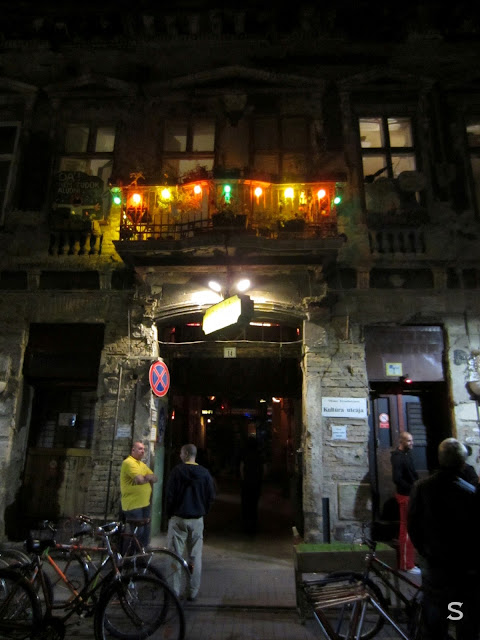 |
| Szimpla |
The place was in a nearly ruined building, combining a cocktail bar with food kiosks, shops and too many other things to describe. It was like nothing we had seen.
After having breakfast at this youth hostel, surrounded by people from all over the world, we spent our last day on Margaret Island. It is in the middle of Danube, mostly covered by parks and there you can find the thermal baths, Budapest is popular for.
We took a ricksha around the island, which was really funny and in the end enjoyed a dancing fountain (well, not quite like those in Las Vegas but still):
After there was nothing else left to do on the island, we took tram 2, which, as our guide said, was the cheapest way to go sightseeing around the city, since its route goes by the river (where most sights are) and you only pay one ticket.
The rest of the day we spent walking around the center, hoping to bump into Bruce Willis, ([spoiler alert] who was supposed to be there filming Die Hard 5), and indulging ourselves with more Hungarian food.
A truly amazing trip. I loved every part of the city. I hope you will too. Oh, I almost forgot... They call Budapest 'Paris of the East' but it's so so beautiful that our guide said he'd like to call Paris 'Budapest of the West'. ;)
Now, I have to get back to my Hungarian. Viszlát!

